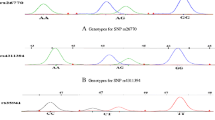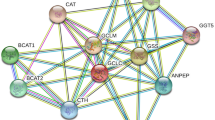Abstract
Numerous reports have demonstrated that activities of nicotinamide N-methyltransferase (NNMT) are significantly associated with type 2 diabetes (T2D), and more than 200 single nucleotide polymorphisms (SNPs) have been identified across NNMT gene to date. Although two SNPs (rs694539 and rs1941404) have been found significantly associated with a variety of noninfectious chronic diseases, the association between NNMT gene polymorphisms and T2D has not been reported yet. In this paper, 558 T2D patients and 442 healthy controls were recruited from Chinese Han population. After a case-control study on the association between the two SNPs (rs694539 and rs1941404) and T2D, we found that the rs1941404 is significantly associated with T2D and the CC carriers at this locus are T2D susceptible population. The following metabolomics study showed that the rs1941404 variation is able to affect the metabolic pathways of tryptophan, tyrosine, and arginine, which may partly explain why the rs1941404 variation is significantly associated with T2D.



Similar content being viewed by others
References
Li JH, Chen W, Zhu XJ, Lin YJ, Qiu LQ, Cai CX, et al. Associations of nicotinamide N-methyltransferase Gene single nucleotide polymorphisms with sport performance and relative maximal oxygen uptake. J Sports Sci. 2017;35(22):2185–90. https://doi.org/10.1080/02640414.2016.1261176.
Li JH, Qiu LQ, Zhu XJ, Cai CX. Influence of exercises using different energy metabolism systems on NNMT expression in different types of skeletal muscle fibers. Sci Sports. 2017;32(1):27–32. https://doi.org/10.1016/j.scispo.2016.06.004.
Liu M, Li L, Chu J, Zhu B, Zhang Q, Yin X, et al. Serum N(1)-Methylnicotinamide is associated with obesity and diabetes in Chinese. J Clin Endocrinol Metab. 2015;100(8):3112–7. https://doi.org/10.1210/jc.2015-1732.
Salek RM, Maguire ML, Bentley E, Rubtsov DV, Hough T, Cheeseman M, et al. A metabolomic comparison of urinary changes in type 2 diabetes in mouse, rat, and human. Physiol Genomics. 2007;29(2):99–108. https://doi.org/10.1152/physiolgenomics.00194.2006.
Kraus D, Yang Q, Kong D, Banks AS, Zhang L, Rodgers JT, et al. Nicotinamide N-methyltransferase knockdown protects against diet-induced obesity. Nature. 2014;508(7495):258–62. https://doi.org/10.1038/nature13198.
Yaguchi H, Togawa K, Moritani M, Itakura M. Identification of candidate genes in the type 2 diabetes modifier locus using expression QTL. Genomics. 2005;85(5):591–9. https://doi.org/10.1016/j.ygeno.2005.01.006.
Souto JC, Blanco-Vaca F, Soria JM, Buil A, Almasy L, Ordoñez-Llanos J, et al. A genomewide exploration suggests a new candidate gene atchromosome 11q23 as the majorde terminant of plasma homocysteine levels: results from the GAIT project. Am J Hum Genet. 2005;76(6):925–33. https://doi.org/10.1086/430409.
van Driel LM, Smedts HP, Helbing WA, et al. Eight-fold increased risk for congenital heart defects in children carrying the nicotinamide N-methyltransferase polymorphism and exposed to medicines and low nicotinamide. Eur Heart J. 2008;29(11):1424–31. https://doi.org/10.1093/eurheartj/ehn170.
Giusti B, Saracini C, Bolli P, Magi A, Sestini I, Sticchi E, et al. Genetic analysis of 56 polymorphisms in 17 genes involved in methionine metabolism in patients with abdominal aortic aneurysm. J Med Genet. 2008;45(11):721–30. https://doi.org/10.1136/jmg.2008.057851.
Sazci A, Sazci G, Sazci B, Ergul E, Idrisoglu HA. Nicotinamide-N-Methyltransferase gene rs694539 variant and migraine risk. J Headache Pain. 2016;17(1):93. https://doi.org/10.1186/s10194-016-0688-8.
Sazci A, Ozel MD, Ergul E, Aygun C. Association of nicotinamide-N-methyltransferase gene rs694539 variant with patients with nonalcoholic steatohepatitis. Genet Test Mol Biomarkers. 2013;17(11):849–53. https://doi.org/10.1089/gtmb.2013.0309.
Sazci A, Ozel MD, Ergul E, Onder ME. Association of nicotinamide-N-methyltransferase (NNMT) gene rs694539 variant with bipolar disorder. Gene. 2013;532(2):272–5. https://doi.org/10.1016/j.gene.2013.08.077.
Sazci G, Sazci B, Sazci A, Idrisoglu HA. Association of nicotinamide-N-methyltransferase gene rs694539 variant with epilepsy. Mol Neurobiol. 2016;53(6):4197–200. https://doi.org/10.1007/s12035-015-9364-2.
Bromberg A, Lerer E, Udawela M, Scarr E, Dean B, et al. Nicotinamide-N-methyltransferase (NNMT) in schizophrenia: genetic association and decreased frontal cortex mRNA levels. Int J Neuro Psycho Pharmacol. 2012;15(6):727–37.
Zhu XJ, Lin YJ, Chen W, Wang YH, Qiu LQ, et al. Physiological study on association between nicotinamide N-methyltransferase gene polymorphisms and hyperlipidemia. Biomed Res Int. 2016;2016:7521942.
Goldberg RB, Mather K. Targeting the consequences of the metabolic syndrome in the Diabetes Prevention Program. Arterioscler Thromb Vasc Biol. 2012;32(9):2077–90. https://doi.org/10.1161/ATVBAHA.111.241893.
Bromberg A, Levine J, Belmaker R, Agam G. Hyperhomocysteinemia does not affect global DNA methylation and nicotinamide N-methyltransferase expression in mice. J Psychopharmacol. 2011;25(7):976–81. https://doi.org/10.1177/0269881110388328.
Trammell SA, Brenner C. NNMT: a bad actor in fat makes good in liver. Cell Metab. 2015;22(2):200–1. https://doi.org/10.1016/j.cmet.2015.07.017.
Belenky P, Bogan KL, Brenner C. NAD+ metabolism in health and disease. Trends Biochem Sci. 2007;32(1):12–9. https://doi.org/10.1016/j.tibs.2006.11.006.
Williams AC, Hill LJ, Ramsden DB. Nicotinamide, NAD(P)(H), and methyl-group homeostasis evolved and became a determinant of ageing diseases: hypotheses and lessons from pellagra. Curr Gerontol Geriatr Res. 2012;2012:302–5.
Li F, Chong ZZ, Maiese K. Cell Life versus cell longevity: the mysteries surrounding the NAD+ precursor nicotinamide. Curr Med Chem. 2006;13(8):883–95. https://doi.org/10.2174/092986706776361058.
Sladek R, Rocheleau G, Rung J, Dina C, Shen L, Serre D, et al. A genome-wide association study identifies novel risk loci for type 2 diabetes. Nature. 2007;445(7130):881–5. https://doi.org/10.1038/nature05616.
Diabetes Genetics Initiative of Broad Institute of Harvard and MIT, Lund University, and Novartis Institutes of BioMedical Research, Saxena R, Voight BF, Lyssenko V, et al. Genome-wide association analysis identifies loci for type 2 diabetes and triglyceride levels. Science. 2007;316(5829):1331–6. https://doi.org/10.1126/science.1142358.
Zeggini E, Weedon MN, Lindgren CM, Frayling TM, Elliott KS, Lango H, et al. Replication of genome-wide association signals in UK samples reveals risk loci for type 2 diabetes. Science. 2007;316(5829):1336–41. https://doi.org/10.1126/science.1142364.
Steinthorsdottir V, Thorleifsson G, Reynisdottir I, Benediktsson R, Jonsdottir T, Walters GB, et al. A variant in CDKAL1 influences insulin response and risk of type 2 diabetes. Nat Genet. 2007;39(6):770–5. https://doi.org/10.1038/ng2043.
Scott LJ, Mohlke KL, Bonnycastle LL, Willer CJ, Li Y, Duren WL, et al. A genomewide association study of type 2 diabetes in Finns detects multiple susceptibility variants. Science. 2007;316(5829):1341–5. https://doi.org/10.1126/science.1142382.
Zeggini E, Scott LJ, Saxena R, Voight BF, Marchini JL, Hu T, et al. Metaanalysis of genome-wide association data and large-scale replication identifies additional susceptibility loci for type 2 diabetes. Nat Genet. 2008;40(5):638–45. https://doi.org/10.1038/ng.120.
Unoki H, Takahashi A, Kawaguchi T, Hara K, Horikoshi M, Andersen G, et al. SNPs in KCNQ1 are associated with susceptibility to type 2 diabetes in East Asian and European populations. Nat Genet. 2008;40(9):1098–102. https://doi.org/10.1038/ng.208.
Yasuda K, Miyake K, Horikawa Y, Hara K, Osawa H, Furuta H, et al. Variants in KCNQ1 are associated with susceptibility to type 2 diabetes mellitus. Nat Genet. 2008;40(9):1092–7. https://doi.org/10.1038/ng.207.
Kong A, Steinthorsdottir V, Masson G, Thorleifsson G, Sulem P, Besenbacher S, et al. Parental origin of sequence variants associated with complex diseases. Nature. 2009;462(7275):868–74. https://doi.org/10.1038/nature08625.
Rung J, Cauchi S, Albrechtsen A, Shen L, Rocheleau G, Cavalcanti-Proença C, et al. Genetic variant near IRS1 is associated with type 2 diabetes, insulin resistance and hyperinsulinemia. Nat Genet. 2009;41(10):1110–5. https://doi.org/10.1038/ng.443.
Saxena R, Hivert MF, Langenberg C, Tanaka T, Pankow JS, Vollenweider P, et al. Genetic variation in gastric inhibitory polypeptide receptor (GIPR) impacts the glucose and insulin responses to an oral glucose challenge. Nat Genet. 2010;42(2):142–8. https://doi.org/10.1038/ng.521.
Dupuis J, Langenberg C, Prokopenko I, Saxena R, Soranzo N, Jackson AU, et al. New genetic loci implicated in fasting glucose homeostasis and their impact on type 2 diabetes risk. Nat Genet. 2010;42(2):105–16. https://doi.org/10.1038/ng.520.
Cui B, Zhu X, Xu M, et al. A genome-wide association study confirms previously reported loci for type 2 diabetes in Han Chinese. PLoS One. 2011;6(7):e022353.
Li JH, Wang ZH, Zhu XJ, Deng ZH, Cai CX, Qiu LQ, et al. Health effects from swimming training in chlorinated pools and the corresponding metabolic stress pathways. PLoS One. 2015;10(3):e0119241. https://doi.org/10.1371/journal.pone.0119241.
Shi YY, He L. SHEsis, a powerful software platform for analyses of linkage disequilibrium, haplotype construction, and genetic association at polymorphism loci. Cell Res. 2005;15(2):97–8. https://doi.org/10.1038/sj.cr.7290272.
Matchett WH. Inhibition of tryptophan synthetase by indoleacrylic acid. J Bacteriol. 1972;110(1):146–54.
Watała C, Kaźmierczak P, Dobaczewski M, Przygodzki T, Bartuś M, Łomnicka M, et al. Anti-diabetic effects of 1-methylnicotinamide (MNA) in streptozocin-induced diabetes in rats. Pharmacol Rep. 2009;61(1):86–98. https://doi.org/10.1016/S1734-1140(09)70010-6.
Jongkees BJ, Hommel B, Kühn S, Colzato LS. Effect of tyrosine supplementation on clinical and healthy populations under stress or cognitive demands—a review. J Psychiatr Res. 2015;70:50–7. https://doi.org/10.1016/j.jpsychires.2015.08.014.
Xia N, Horke S, Habermeier A, Closs EI, Reifenberg G, Gericke A, et al. Uncoupling of endothelial nitric oxide synthase in perivascular adipose tissue of diet-induced obese mice. Arterioscler Thromb Vasc Biol. 2016;36(1):78–85. https://doi.org/10.1161/ATVBAHA.115.306263.
Hambrecht R, Hilbrich L, Erbs S, Gielen S, Fiehn E, Schoene N, et al. Correction of endothelial dysfunction in chronic heart failure: additional effects of exercise training and oral L-arginine supplementation. J Am Coll Cardiol. 2000;35(3):706–13. https://doi.org/10.1016/S0735-1097(99)00602-6.
Kaneto H, Fujii J, Seo HG, Suzuki K, Matsuoka T, Nakamura M, et al. Apoptotic cell death triggered by nitric oxide in pancreatic beta-cells. Diabetes. 1995;44(7):733–8. https://doi.org/10.2337/diab.44.7.733.
Funding
This work was supported by the National Natural Science Foundation of China (NSFC 21365013).
Author information
Authors and Affiliations
Corresponding author
Ethics declarations
The investigation was approved by the local ethics committee at Jiangxi Normal University, and all participants provided the written informed consents. This study conforms to the latest revision of the Declaration of Helsinki.
Conflict of interest
The authors declare that there are no conflicts of interest.
Rights and permissions
About this article
Cite this article
Li, JH., Wang, YH., Zhu, XJ. et al. Metabolomics study on the association between nicotinamide N-methyltransferase gene polymorphisms and type 2 diabetes. Int J Diabetes Dev Ctries 38, 409–416 (2018). https://doi.org/10.1007/s13410-017-0601-2
Received:
Accepted:
Published:
Issue Date:
DOI: https://doi.org/10.1007/s13410-017-0601-2




